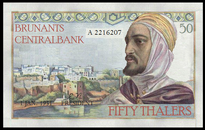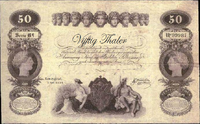Brunant has been issuing banknotes since the early 18th century but only since 1868 has the Central Bank officially issued notes. All of the notes issued from 1868 to 1999 were designed and printed by the Central Bank in Brunant (BCB Printing).
Decimal series[]
1987 series[]
The 1987 Series was the last series of Thaler notes made in Brunant before the introduction of the Euro. All but the 100 Th. note were redesigned, and featured modern designs partly based on the previous series. The 100 Th. was issued in 1990.
In 1995 the government began planning to introduce a whole new series with modern geometric patterns and designs. Specimens were issued for the 500 thaler note in 1999 but were not put into circulation, with the Euro set to be introduced soon.
1970 series[]
The series 1970 was the first truly modern issue of Thaler notes. Despite not being as stunning as the previous colorful notes, these were much more durable and secure.
All the notes in the series featured colorful patterned backgounds (guilloche) and featured engraved printing to the added security. The notes also featured watermarks to ensure the paper wasn't easily counterfeited.
The series featured Founding father Philippe de Bryas on the 5 thaler, James Carrington on the 10 thalers, Queen Maria Amalia on the 20 thalers, El-Reis on the 50 thalers, Marten II on the 100 thalers and Leuvis II on the 500 thalers. All the notes featured scenes and objects linked to the person featured.
The series was redesigned in 1987-1990 to replace these notes.
1959 series[]
The Series 1959 was issued to replace the previous notes. The 2 Th. note was the first to be released, in late 1959, featuring a simple design. The rest of the series was printed in a similar style, but reservations by the government on its susceptibility to being counterfeited led them to cancel the issue and have the notes destroyed. Rumors still persist that a few such notes were saved, but none have been verified.
A new re-issue of all the notes (except for the 2 thaler) was done in 1960 though bearing the date "1959". These notes featured colorful bird designs on the reverse of the notes and had important personalities on the front (some based on the previous series). This series has been considered the most beautiful Brunanter notes by experts and the public alike. In August 1960 the Central Bank released a 1000 thaler note into circulation. Due to its high value (approx. $340 in 1960-61) they rarely circulated and were last printed in 1962. The 2 thaler note was printed until 1966, with that year's issue sold only in special sets (for King Johan II's golden jubilee). These notes continued in circulation until 1970.
1951 series[]
The Series 1951 was introduced to replace the previous inflationary notes. These were the first fully bilingual notes. Prior to that, they were in Dutch on the obverse and English on the reverse.
The first issue in the series was the 100 thalers which featured Marc'Antonio Brighi and an ancient mosaic from the Seven Cities. The next issue was the 500 thalers note with James Carrington and his endeavors. Next came the 5 thalers with Adrian I, Queen Francesca and early Koningstad; the 10 thalers with Maria Amalia and 17th century Brunant; the 20 thalers with Adrian van Haecht and military scenes and the 50 thalers with El-Reis and Arabian Brunant. The 5, 10, 20 and 500 thaler notes were designed by John Salles.
The notes were issued in 1951 and re-issued in 1952 and 1955 since there were problems with the notes in that they wore out rather easily because of the colorful designs and the thin paper. A 1000 thaler specimen, featuring Filip Van Buskirk and democracy themes was made in 1954 but never issued. In 1959 these notes were replaced by another series. This is one of the rarest series of thaler notes and have become highly collectible. These notes were inspired by the BdF 1940s series and in turn inspired the 1959 Libertan moneta notes, printed and designed in Brunant.
1945/48 series[]
The 1945 and 48 series of notes was introduced to replace the previous series 1921. Many of those notes were stolen by Nazi soldiers throughout the occupation in the 1940s and there was a need to remove them from use. Only the 100 and 500 thaler notes were issued as inflation was still high, but inflation was soon curbed.
As well, the government put into circulation a reserve series of small-denomination notes. These were printed in 1931 by the Banque de France with the intention of replacing the series 1921, but were never released. The notes were issued in the amounts of 10, 20 and 50 thalers and had the bright colors and designs used by French notes of the time. These notes circulated from 1946 to 1950, and are thus very hard to fins (as many notes were later shredded).
1921 series[]
The 1921 series was the longest-lasting issue of thaler notes, being printed until 1941. They were designed by Willem Hartman and featured colorful detail detail and design. Compared to the previous issue, they were less muted colors but were more secure and easier to print. Notes were re-issued in 1928 and 1936. A brief run of some 5000 10 and 20 th. notes were printed in 1946 but saw limited circulation.
1913 series[]
The 1913 banknotes were the first decimal and post-inflation issues by the Central Bank. The notes featured bright colors, lots of allegorical, as well as historic figures. Notes were issued in values of 5, 10, 20, 50 and 100 thalers. In 1915, notes (dated 1913) were issued in the values of 2 and 500 thalers. These notes were printed until 1921, when a new series was issued. For collectors, these notes are very hard to find, especially in good condition. The 500 thaler note is also the rarest of this denomination in any series and can command prices of €550-650 in very fine condition and over €1000 uncirculated.
Guldenthaler[]

1868 Thaler

50 thaler 1881
1865 series[]
The 1865 banknotes (red seal) were a design proposed by the Central Bank as the first standard issue. Notes in the amounts of 5 and 10 thalers were printed but ultimately they were never issued. They were ordered destroyed but approximately 900 notes were saved. An original in good (fine) condition can be worth upwards of 1000 Euros. There are many forgeries of these and tourists are fooled into buying them.
1868 series[]
The 1868 Series was the first definitive issue by the Central Bank. They were printed in 1868 and 1869 and were known as the "blue-seal" notes, since they bore a blue seal of the bank. These notes came in Dutch and English-language issues.
1871/1881 series[]
The 1871 series was the second issue of the Central Bank. These were known as the "red-seal notes". They were issued until 1873. They were soon followed by the seal-less issue of 1874; these notes were issued in denominations of 1, 5, 10, 20, 50, 100 and 200 thalers. In 1878 a 1/2 thaler banknote was issued but due to easy falsification it was taken out of circulation in 1880. In 1881(85) came the fifth issue of Guldenthaler notes.
Inflationary issues[]
By the early 1900s the Brunanter thaler began to fall in value compared to other currencies. In 1909 the government issued notes of 1000 thalers, which was followed with a 5000 note in 1910 and notes of 10 and 20,000 in 1912. By then, with the plan for decimal currency on track, it was decided to redenominate Brunant's currency, which became effective on 1 January 1913 (1000 guldenthaler = 1 new thaler).
Early banknotes[]

An early note
1663 notes[]
The first paper thalers issued by the Brunanter government came in 1663. It was during the Brunanter Civil War and the royalist government of King Willem II was desperately short on cash. Coin mintage was significantly reduced and copper coins weren't minted altogether. Thus the state introduced promissory notes in 1663; they promised to pay the bearer the stated sum in coin in 1664. The state issued 64,200 thalers worth of these notes in denominations of 1/2, 1, 3 and 10 cent; later issues came in 1/4, 1/2, 1 and 10 thalers. But, public distrust in paper, its limited usage and an unwillingness to convert them to paper led the notes to lose purchasing power. After the end of the war, these paper notes lost all their value. In 1968 the Central Bank, preparing for the centennial of the Bank, discovered two of these notes in their archives. Being the only surviving exemplars, they are now extremely valuable.
Papierthaler[]

50 Thalers, 1705
In 1703 a shortage in silver forced the government to introduce paper notes of 10, 12.5 and 20 Thalers. A lack of gold coins and a prolonging of the shortage in silver led to distrust and a rise in inflation. By 1704 a silver thaler was worth 21 paper ones and in 1705 around 240-250. That year notes of 50, 100 and 150 thalers were issued which were soon rendered worthless (by January 1706 one needed 600 paper thalers to get a silver one). The final Papierthaler issue of March 1706 included notes of 200, 400, and 500 thalers.
Private issues[]

20 thalers, Cape Cross

Charles Town Bank 5 Th. 1870s

100 Th. Staatsbank 1882-87
Cities and Parishes[]
Since the 1700s many of the parishes in Brunant began issuing their own currency to use for minor transactions. Cape Cross Parish became the first to issue its own notes, in 1719. The General Authority of the parish issued notes "backed by the publick treasurys of the parish in silver and gold". But, there was such a large amount of printing, little accountability, dwindling gold reserves and high falsification that the notes depreciated quickly. They were not accepted in other parishes and by 1720-21 the government in Koningstad refused to accept them. The last notes were printed in 1721. It would be many more years before they would be issued again. During the Franco-Brunanter War in 1758, Brunant Parish found the need to issue paper money. They faced a shortage of coinage and were not receiving cash supplies. In this case they were not backed by coin, but instead became an actual accepted currency and not just a promissory note. Grijzestad was forced to issue their own notes during the war, but the lack of accountability led them to overissue them. Inflation led them to print 10,000 thaler notes in late 1758, and though they were "redeemable in coin in 1760, with a 2 per cent annual interest", they were never received in the end and lost all value. Other towns and parishes issued their own notes in order to account for lack of coin during 1757-1760.
Private banks[]
Many of Brunant's private banks began issuing banknotes in the mid-1800s, starting with the Standard Bank of Grijzestad in 1829. Between 1829 and 1916, there were 27 banks which issued banknotes. As banknotes were not regularly issued by the state until 1868 and there was a growing need for them in the 19th century, private banks stepped in an issued notes in all denominations. Other banks issuing private notes included the Charles Town Bank, Staatsbank Brunant and De Grijzestad Bank. Private banks guaranteed these notes with reserves in their own coffers, but when a bank went broke or shut down oftentimes their notes were never redeemed and became unaccepted for general usage and commerce. Banks were able to issue notes until 1934, when the Central Bank of Brunant was given a monopoly on the issuing of notes.












































